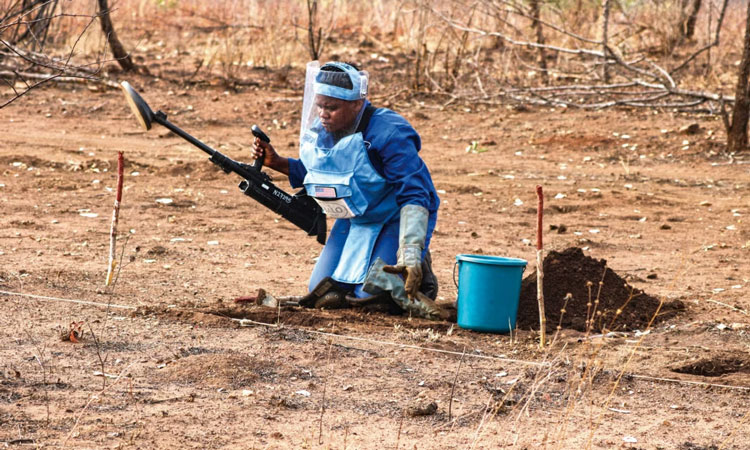Removing landmines protects people and restores habitats

US government-sponsored demining efforts, such as in Zimbabwe, protect people, spur economic development and promote wildlife conservation. (Courtesy of the HALO Trust)
Zimbabwe’s war of liberation ended in 1979, but danger remains for cattle herder Elvis Chauke. Chauke grazes animals near a minefield along Zimbabwe’s south-eastern border. He has lost livestock and fears for the safety of his children.
US-backed demining operations in areas near the village of Chilotlela in Zimbabwe are a relief for Chauke.
“Even though they were raised to stay out of the minefield and we haven’t had a human accident in years with kids you never know,” says Chauke in the 22nd report, To Walk the Earth in Safety, released April 4. April was issued by the US Bureau of Politico-Military Affairs of the Department of State.
“It’s a great relief to know that some of the mine threat near Chilotlela has already been mitigated,” he adds.
Working with international partners, the US government’s Conventional Weapons Destruction Program is clearing land mines and other explosive remnants of war around the world. US funding also helps secure or destroy surplus or improperly secured small arms and light weapons that could fall into the hands of criminals and terrorists.
According to Assistant Secretary of State for Politico-Military Affairs Jessica Lewis, clearing explosive remnants of war protects people and paves the way for economic development and post-conflict environmental restoration.
“With deadly land mines removed and booby traps and improvised explosive devices cleared, the wheat fields are now ready for harvest,” says Lewis in the report’s introduction. “Children can walk to school on a trail, families can return to their partially destroyed homes and elephants can roam through grasslands.”
Since 1993, the United States has invested more than $4.6 billion to safely clear landmines and explosive remnants of war in more than 120 countries.
From October 1, 2021 to September 30, 2022, the period covered in the report, the United States invested more than $376 million in conventional arms elimination efforts in more than 65 countries and territories around the world. These efforts resulted in achievements including the destruction of:
- 37,564 landmines and 9,099 improvised explosive devices or components.
- 200,112 explosive remnants of war.
- 14,165 surplus small arms and light weapons and 3,938 tons of unserviceable ammunition.
US-funded efforts to eliminate conventional weapons also resulted in the safe return of more than 243 million square meters of land to communities.
The United States also trained demining teams in Ukraine, where the full-scale invasion of Russia in February 2022 may have contaminated an estimated 174,000 square kilometers with land mines and explosives, the Ukrainian government estimates. The dangers threaten to injure or kill civilians, stop or delay the delivery of medical supplies and other humanitarian and emergency assistance, prevent displaced people from returning home, and hamper reconstruction. Landmines and other explosive remnants of war can continue to harm people, livelihoods, livestock and wildlife decades after a conflict has ended.
In southern Zimbabwe, where Chauke herds livestock, landmines threaten wildlife and hamper tourism and economic development. The Sengwe Wildlife Corridor, which connects Zimbabwe’s Gonarezhou National Park to South Africa’s world-famous Kruger National Park, is riddled with land mines and explosives, threatening migrating elephants, wildebeest and other wildlife.
The United States provided US$3.25 million for landmine clearance and weapons destruction in Zimbabwe from late 2021 to late 2022, and nearly US$29 million for explosives and weapons destruction in Zimbabwe since 1998.
In Angola, where a 40-year conflict ended in 2002, from late 2021 to late 2022, US-funded demining efforts have returned more than 2 million square meters of land to local communities. Since the end of 1994, the United States has committed more than $158.5 million for the destruction of conventional weapons in Angola and freed more than 469 million square meters of land for productive use.
Efforts to clean up Angola’s explosives are focused on areas of significant population growth and support conservation in the Okavango River Basin, which is a source of water for many people in Angola and Botswana and is home to rich biodiversity in both countries.
“US investment in Angola’s efforts to eliminate conventional weapons not only saves lives and increases security – it also supports the development of new economic opportunities in Angola, such as ecotourism in the Okavango Delta region,” the US State Department said.


